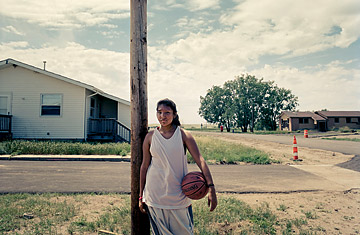
Spirit Grass, 13, is part of a family of six in Thunder Butte, S.D., who until recently survived on $3,500 a year.
(2 of 4)
Why the shift? Some suburbs are losing jobs, leaving their residents poorer. Others are adding jobs but in low-wage industries like retail, attracting poor families from elsewhere. Affluent suburbanites are moving to city centers, while new immigrants are heading straight to the suburbs, where they're faced with challenges like limited public transport and a lack of social safety nets. Resources for food assistance, job training, drug treatment, adult education, emergency housing and English-as-a-second-language classes are often sparser in suburbs unaccustomed to dealing with poverty and its web of related conditions. Health care for low-income families and the uninsured also lags, which is particularly troublesome since health problems both trigger and perpetuate poverty. Which leads to ...
MYTH NO. 2: POVERTY IS SIMPLY ABOUT NOT HAVING ENOUGH INCOME
Jessica Jakubac, an edgewood parent, lost her last job because her son woke up one morning with an inflamed leg. Jakubac rushed him to a clinic and would have called her office to say she'd be late, except that she doesn't have a home phone (too expensive) and her cell-phone service had recently been cut off because she couldn't pay the bill. By the time she called from the doctor's office later that day, she'd been logged as a no-show, which compounded the numerous late arrivals already on her record because of chronic trouble with her car: it needed a new battery, but she couldn't afford one, so she often had to find a jump start first thing in the morning.
Living with a small financial margin isn't just about not being able to afford things; it's also about not being able to get things done. A few times a year, the United Way of Central Maryland runs a poverty simulator in which middle-class participants are given a set of tasks, along with situational constraints like relying on family for child care, taking the bus and depending on the money from a teenager's after-school job. Some people grow so frustrated that they quit before the exercise is over.
Volatility also plays a major role in what might be called the chaos of poverty. Over the course of a year, 20% of families in the poorest fifth will see their incomes drop by at least half from one four-month period to the next, according to Urban Institute research. Poverty often goes hand in hand with shifting work schedules, child-care arrangements and transportation and living situations--all of which are taxing to manage and have a negative effect on children.
MYTH NO. 3: GETTING PEOPLE OUT OF POOR NEIGHBORHOODS IS THE ANSWER
Moving to opportunity was one of the greatest antipoverty experiments in U.S. history. Authorized by Congress in 1992, the 15-year randomized trial gave 4,600 low-income families in poor neighborhoods a chance to move to less distressed areas. It reflected a popular belief about the poor: that the issues of concentrated poverty, especially in cities, are so entrenched and complex that removing people from their environment--away from bad schools, high crime, a lack of affordable quality housing, drug markets and the breakdown of informal social control--is the best way to set them on a path to a middle-class life.
